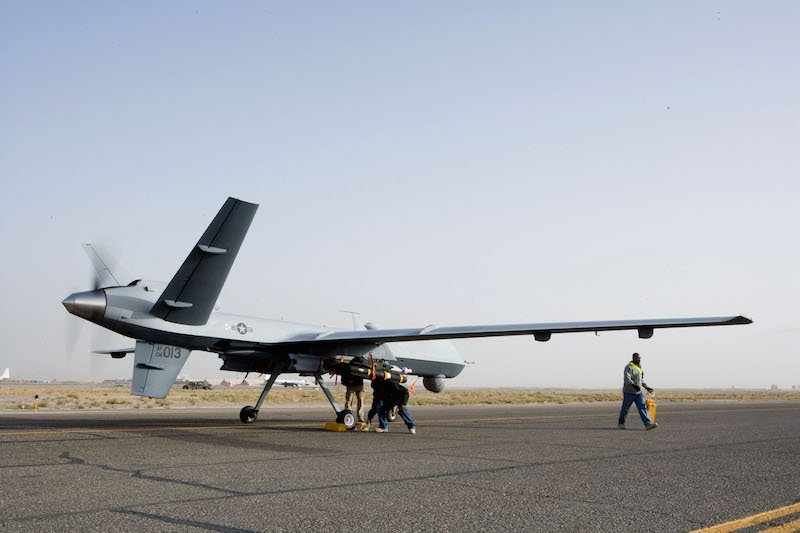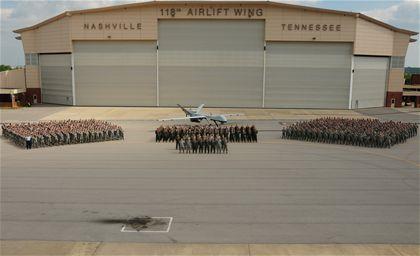
As the military leans ever harder on unmanned aircraft of all sizes, it’s created a problem for the National Guard, whose mission is primarily on the home front. The largest, most sophisticated drones aren’t exactly welcome here at home. So the state-based units are pushing for more capability to make use of remote-piloted planes in American airspace.
Only once in recent years has a high-powered National Guard drone been put to work domestically. It was an MQ-1 Predator, which has a wingspan of nearly 60 feet. It can carry Hellfire missiles and fly unseen from the ground. In the fall of 2013, instead of tracking down terrorists, it kept tabs on the Rim Fire in Yosemite.
“This is a historical moment,” Col. Dana Hessheimer said in a highlight reel produced by the California Guard and put to a dramatic score. “We’ve been fighting for this to support the American people on the home soil.”
The Predator took off and hovered above the smoke and flames, feeding fire commanders live infrared video.
Guardsmen across the country were pumped. While they deploy overseas when the Pentagon calls them up, that’s not the day-to-day mission.
“Most of the time, I work for the governor,” says Col. Keith Albritten, vice commander of the 118th Wing based at Nashville’s Berry Field. “How can I help the governor? How can I help him in his state with the problems that he has?”
Up until a few years ago, the 118th flew C-130 cargo planes. Then, it was easy to be useful. The hulking prop planes would ferry supplies around the state during disasters. But now the unit only has the MQ-9 Reaper—the latest high-speed, high-altitude drone.
But the Reapers are nowhere to be found in the cavernous hangar by Nashville International Airport.
“Keep looking my friend. They are not here,” Albritten says while giving WPLN a tour. “We’re working to try and get iron in the state so that they’re available for the Governor to use in a state of emergency.”
Like several of the Guard units with drone missions, his aircraft are housed overseas, controlled via satellites. According to the National Guard bureau, five of the 12 units that fly Reapers and Predators have them in their possession. The others essentially take control of the drone once a local crew—usually overseas—gets the unmanned vehicle in the air.
Even the work of the Guard’s pilots is so protected, Albritten won’t point out what building his pilots are in, other than to confirm they are on the premises.
“Can’t really say,” he says. “Operational security. I can’t really talk about that.”
This secrecy is why the prospect of military drones soaring above the U.S. raises suspicion, even if they’re monitoring rising floodwaters or surveying damage from a tornado outbreak.
State Sen. Mae Beavers of Mount Juliet sponsored a new law meant to protect Tennesseans from police drones. She has similar concerns about the military, which has proposed offering surveillance for drug busts.
“The very idea that someone could use a drone to spy on you through your windows at home or in the privacy of your back yard even, I think that bothers people,” she says.
Col. Albritten says he has no interest in “you being in your backyard flipping burgers,” and he cites multiple layers of oversight. According to a National Guard spokesman, no less than the Secretary of Defense has to sign off in any U.S. operation. And Albritten says all the video will be considered unclassified.
Still, there’s some pushback, even among drone supporters.
“First of all, you’re using platforms that are known killers,” says Richard Davis, an assistant fire chief in Austin, Texas. “With the name ‘Reaper,’ the first thing people think are these are killing machines.”
Davis has researched and written about unmanned aircraft and advocates for relying on them in emergencies. But he worries that the broad use of military drones would make the already-suspicious public even more worried. Davis compares it to “bringing a bazooka to a knife fight.”
“In some cases, it would be overkill,” he says.
Still, Davis admits the military drones can do far more than his quadcopter, which is effectively a flying camera that basically has to stay within line of sight.
Guardsmen know they’ve got some public relations work to do before regularly flying Reapers around the U.S. But Tennessee Guard Commander Max Haston sees the remote-piloted aircraft as no more dangerous than the rest of his arsenal, which includes other spying equipment, like listening devices.
“I can’t take it home and turn it on my neighbor’s house and hear what he’s doing in there,” Haston says. “That’s illegal.”
Haston notes that the public doesn’t seem to be worried about his current capabilities but says he understands the anxiety over something new and unknown like unmanned aviation.
“I think the public has a fear of the government, you know, big brother spying on them. But it’s less of a threat than driving down I-40 or I-65 with all of the cameras on the road,” Haston says. “It’s there!”
Guard Drones At A Glance
- Eight units around the U.S. fly the most sophisticated drones. Two have Reapers. Six have Predators.
- Four other units are in the process of converting to an unmanned mission.
- Five units have the capability to take off and land in the continental U.S., primarily for training missions.
- Air National Guard launching sites are at Southern California Logistics Airport, Fort Drum in upstate New York, Fort Polk in Louisiana, Fort Huachuca in Arizona and Grand Forks Air Force Base in North Dakota.
- Three units, including Nashville’s 118th Wing, pilot drones only from afar.


